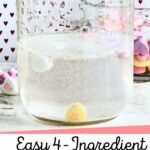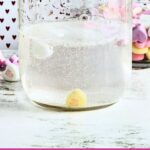Easy 4-Ingredient Dancing Hearts Experiment
This Easy 4-Ingredient Dancing Hearts experiment is a long-standing project favorite for kids. Not only is it completed with one of the sweetest Valentine’s Day treats of the season, but it’s also a hands-on experiment that makes learning fun. If you’re looking for a fun STEM-related activity to do this Valentine’s Day, this is it!
Looking for more activities like this? Check out these awesome Valentine’s Day Science Activities that kids will love.
Using only five ingredients, four of which you’ll probably already have around the home, this is an experiment that can be used to teach the scientific method and be a great conversation starter (thanks to messages on the hearts).
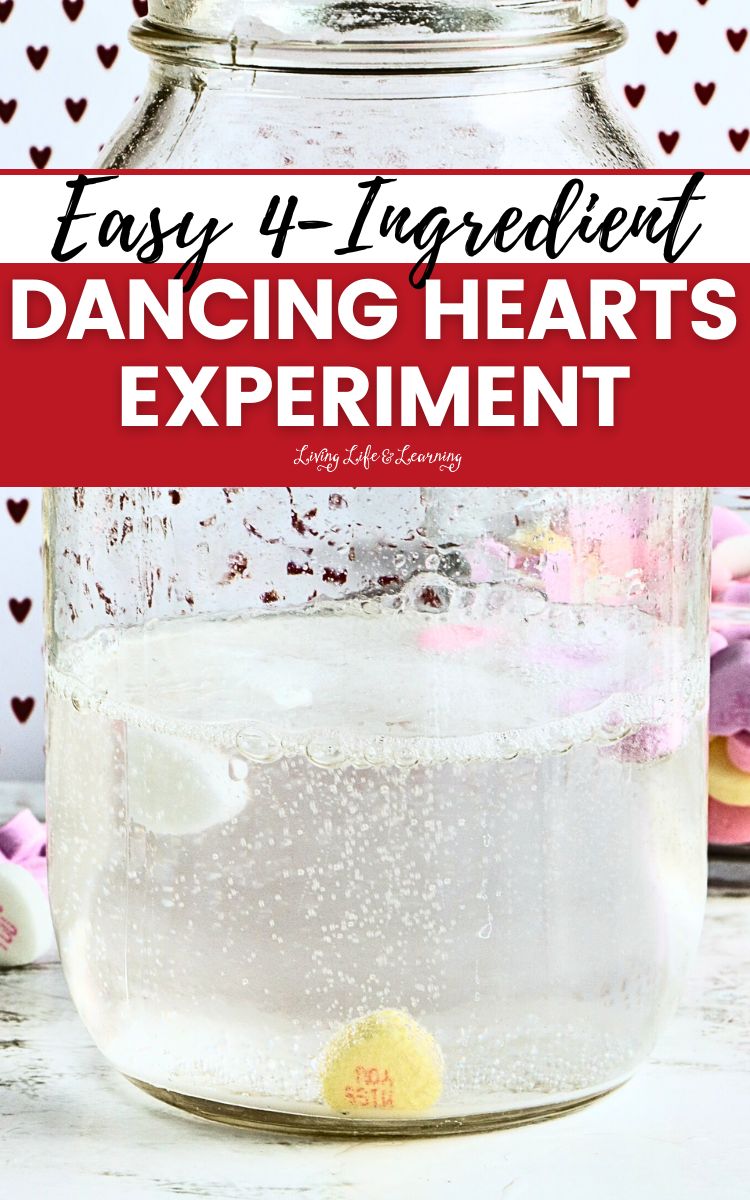
This post may contain affiliate links meaning I get commissions for purchases made through links in this post. Read my disclosure policy here.
The Science Behind the Dancing Hearts
The two main ingredients that make the dancing hearts actually “dance” are baking soda and vinegar. By itself, baking soda is an alkaline compound resembling a finely milled powder. It’s commonly used in a variety of baked goods, such as pancakes, quick bread, muffins, and some fried foods. Beyond cooking, baking soda is also a go-to ingredient for DIY cleaning solutions.
Vinegar, on the other hand, is an acid and another kitchen staple. It can also be used as a cleaning solution, in foods, and just so happens to be the primary reason why this dancing hearts experiment works!
When these two ingredients are combined, it starts the process of creating carbon dioxide gas. This becomes evident when you see the formation of bubbles in the foaming mixture. When the candy hearts are added you’ll notice them lifting to the top and falling back down once the bubbles lifting them have dissipated.
See more Valentine’s Day Activities for Kids
Recommended Valentine’s Day Books
Bring more excitement to the season with these Valentine’s books for little kids. You will love these great stories about hearts, love, and Valentine’s Day.
Day It Rained HeartsThe Biggest Valentine EverTurkey’s Valentine Surprise (Turkey Trouble Book 6)There Was an Old Lady Who Swallowed a Rose!A Crankenstein ValentineLove, Escargot
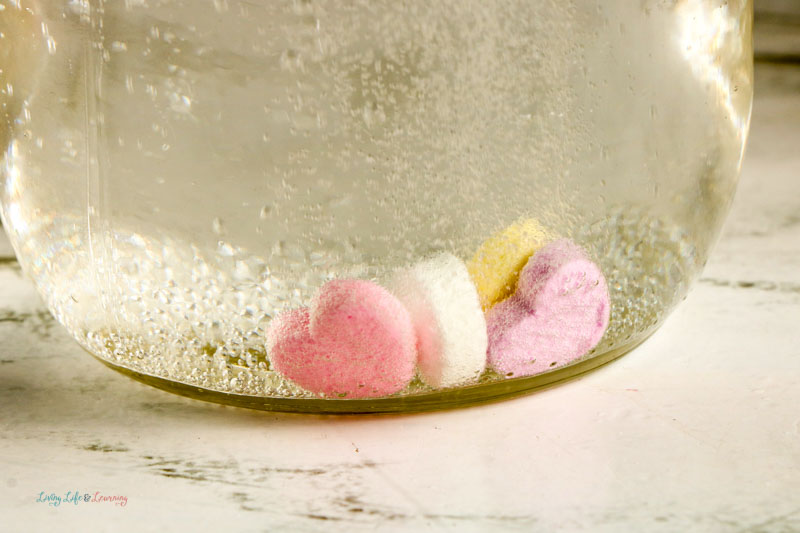
Recommended Valentine’s Day Printable Activities
Valentine’s Day Color by Addition Worksheets
Practice addition skills up to 20 with these fun Valentine’s Day color-by-number addition worksheets. A fun way to add math to your school day without boring math worksheets. Instead, figure out what picture will unfold after you color in each space.
Little Learners Print & Go Activity Kit: Valentine’s Day
Valentine’s Day is here and learning can be turned into a fun heart’s day for kids. Get this huge pack of printable math and literacy activities for your young learners at home!
How to Create a Lesson Plan for the Dancing Heart Experiment
If you like to use experiments in unit studies or as their own lessons, then these lesson plan suggestions and ideas will help you do just that. These are perfect for homeschooling multiple kids and those varying in age and grade level.
For starters, decide when you’d like to do this experiment. Do you want to wait until closer to Valentine’s Day, or do it the day of?
Here’s how to create a study with this experiment as the grand finale for creating a sample lesson plan.
Here’s what that would look like:
- Introduce the compounds used in the dancing hearts experiment (water, vinegar and baking soda). Talk about how they are used in the kitchen for cooking and the main ingredients in supplies for a more natural way of cleaning.
- Since these ingredients are natural, have a taste test. Have your kids describe what they taste (bitter, sour, etc.). Go over the health benefits of these substances.
- Play a guessing game using foods, drinks, and cleaning supplies, and have your kids guess which ingredients go in them. For example, pancakes would have baking soda whereas a picture of a salad dressing would have vinegar in it.
- Bake a dessert that uses baking soda.
- Do the Dancing Hearts experiment and review concepts taught throughout the week.
Recommended Science Experiment Books
Grab one of these science experiment books to give you ideas for your own experiments to conduct with your kids and make sure you have enough supplies to get them done.
STEAM Kids: 50+ Science / Technology / Engineering / Art / Math Hands-On Projects for KidsThe Curious Kid’s Science Book: 100+ Creative Hands-On Activities for Ages 4-8Awesome Engineering Activities for Kids: 50+ Exciting STEAM Projects to Design and Build (Awesome STEAM Activities for Kids)Awesome Physics Experiments for Kids: 40 Fun Science Projects and Why They Work (Awesome STEAM Activities for Kids)Awesome Kitchen Science Experiments for Kids: 50 STEAM Projects You Can Eat! (Awesome STEAM Activities for Kids)100 Easy STEAM Activities: Awesome Hands-On Projects for Aspiring Artists and Engineers
Recommended Valentine’s Day Activity Kits
Keep your kids busy having fun and tons of learning with these recommended educational Heart’s Day activity kits!
Valentines Day Dig Kit – Dig 24 Sea Animal Toys Valentines Game for Kids Classroom Gifts Exchange Party Favors Valentines Day Gifts for KidsValentine Heart Charm Bracelet Craft Kit – Crafts for Kids and Fun Home ActivitiesValentine’s Day Activities for Kids: I Spy Valentine’s Day Book For Kids: A Fun Coloring and Guessing Game BookFennoral 6 Pack Heart Dream Catcher Craft Kit for Kids Paint You Own Love Heart Dream Catcher DIY Coloring Valentine’s Day Wooden Art and Craft for Art Activity Project Valentine’s Day DecorationPLUS PLUS – Puzzle by Number – 250 Piece Hearts – Construction Building Stem/Steam Toy, Interlocking Mini Puzzle Blocks for KidsValentine’s Day Coloring Book For Kids: 50 Cute and Fun Love Filled Images: Hearts, Sweets, Cherubs, Cute Animals and More
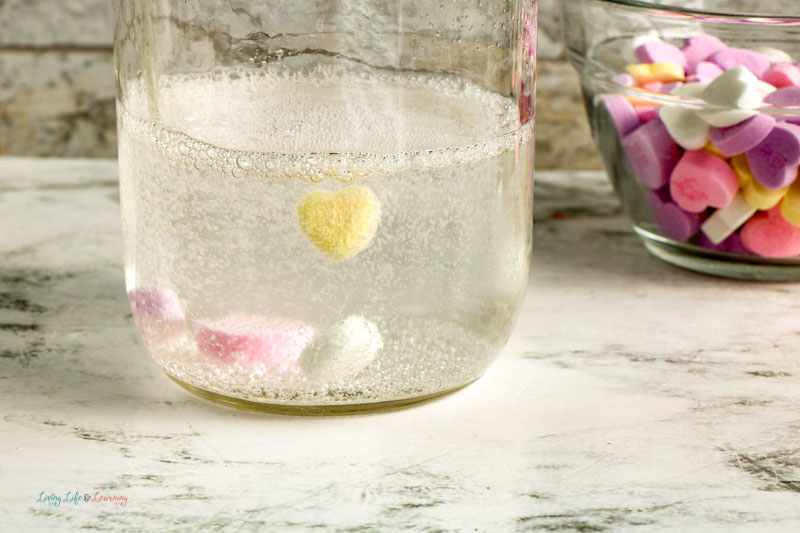
Time to Experiment!
With the lesson plans in mind and just a few ingredients (listed below), you and your kids are ready to have some learning fun in the kitchen with this dancing hearts experiment. Just a few things to keep in mind:
- Although the ingredients for this experiment are natural and not harmful, make sure your kids are supervised at all times (especially with the candy hearts).
- Have some fun by making it a family effort. Give each child a certain “job” to do and let them know their role is important in making it work.
- Gather all the supplies you need at once to make it a stress-free experience (and experiment).
- Most importantly, have fun!
If you have older kids participating, consider letting them use the Scientific Method before starting the experiment. They can also create a small report about the process and end results.

Dancing Hearts Experiment Supplies
- 1 cup water
- 1 tablespoon baking soda
- ½ cup vinegar
- Conversation hearts or other Valentine’s Day candy
- Jar or bowl
How to do the Dancing Hearts Experiment?
- Mix the water with the baking soda until the baking soda is dissolved. Pour water into the container.
- Add the candy to the container.
- Slowly pour the vinegar into the container.
- If the candy sticks to the bottom, give it a slight stir.
- Even if the candy settles, continue watching as the hearts flip over from time to time.
Ways to expand the activity:
- Change the type of container
- Change the type of candy
- Change the ratio of water to baking soda
Be aware that increasing the depth of the water too deep makes it harder to get the candy dancing as the vinegar cannot easily get to the bottom.
I’d love to hear from you! Did you try the Dancing Hearts experiment? Let me know in the comments below!
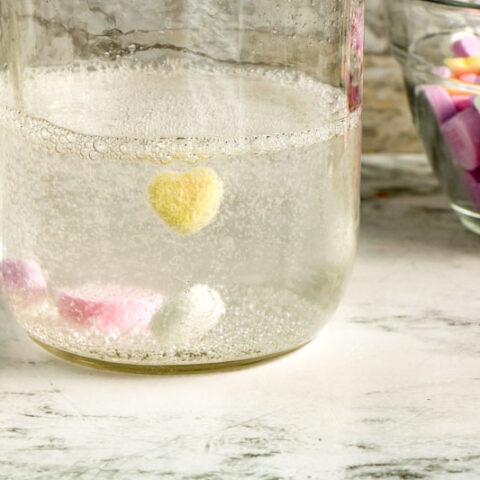
Dancing Hearts Experiment
Your kids will marvel as they see hearts dance in this fun science experiment perfect for Valentine's Day!
Materials
- Water (1 Cup)
- 1 Table spoon of baking soda
- 1/2 Cup of Vinegar
- Jar or bowl
- Conversation hearts candies or Valentine's Day candies
Instructions
- Help your kids mix a tablespoon of baking soda into one cup of plain water. Mix it well then pour the mixture into your bowl or jar.
- Add your heart candies to the bowl of water and baking soda mixture.
- Slowly pour a half cup of vinegar into the water and baking soda mixture.
- If your candies stick to the bottom of your bowl, give it a slight stir.
- Your kids will surely tap dance in excitement as they see the heart candies flip over and "dance" inside the bowl! Hooray!
Recommended Products
As an Amazon Associate and member of other affiliate programs, I earn from qualifying purchases.
Discover the magic of science with your children through our simple yet enthralling dancing hearts experiment using 4 ingredients, where fun meets learning and creates memories to cherish!
More Valentine’s Day Science Activities
Jelly Bean Hearts STEM Challenge
Candy Heart Science Experiments
Fizzy Hearts Science Experiment
Heart Jelly Beans STEM Challenge
DIY Pink Fizzy Bath Bombs by Darcy and Brian
Floating Dry Erase Hearts Experiment by The Craft at Home Family


